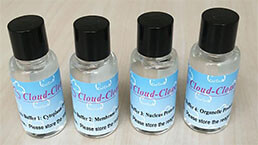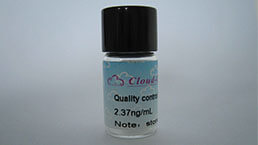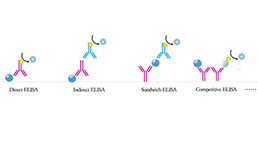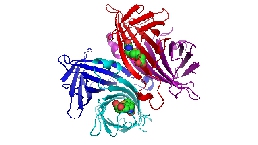Packages (Simulation)

Reagent Preparation

Image (I)
Image (II)
Certificate


ELISA Kit for Indoleamine-2,3-Dioxygenase (IDO)
CD107B; INDO; Indoleamine-Pyrrole 2,3 Dioxygenase
- Product No.SEB547Hu
- Organism SpeciesHomo sapiens (Human) Same name, Different species.
- Sample TypeSerum, plasma, tissue homogenates, cell lysates, cell culture supernates and other biological fluids
- Test MethodDouble-antibody Sandwich
- Assay Length3h
- Detection Range0.312-20ng/mL
- SensitivityThe minimum detectable dose of this kit is typically less than 0.127ng/mL.
- DownloadInstruction Manual
- UOM 48T96T 96T*5 96T*10 96T*100
- FOB
US$ 466
US$ 665
US$ 2993
US$ 5653
US$ 46550
For more details, please contact local distributors!
Specificity
This assay has high sensitivity and excellent specificity for detection of Indoleamine-2,3-Dioxygenase (IDO).
No significant cross-reactivity or interference between Indoleamine-2,3-Dioxygenase (IDO) and analogues was observed.
Recovery
Matrices listed below were spiked with certain level of recombinant Indoleamine-2,3-Dioxygenase (IDO) and the recovery rates were calculated by comparing the measured value to the expected amount of Indoleamine-2,3-Dioxygenase (IDO) in samples.
| Matrix | Recovery range (%) | Average(%) |
| serum(n=5) | 80-104 | 97 |
| EDTA plasma(n=5) | 79-105 | 94 |
| heparin plasma(n=5) | 96-103 | 99 |
Precision
Intra-assay Precision (Precision within an assay): 3 samples with low, middle and high level Indoleamine-2,3-Dioxygenase (IDO) were tested 20 times on one plate, respectively.
Inter-assay Precision (Precision between assays): 3 samples with low, middle and high level Indoleamine-2,3-Dioxygenase (IDO) were tested on 3 different plates, 8 replicates in each plate.
CV(%) = SD/meanX100
Intra-Assay: CV<10%
Inter-Assay: CV<12%
Linearity
The linearity of the kit was assayed by testing samples spiked with appropriate concentration of Indoleamine-2,3-Dioxygenase (IDO) and their serial dilutions. The results were demonstrated by the percentage of calculated concentration to the expected.
| Sample | 1:2 | 1:4 | 1:8 | 1:16 |
| serum(n=5) | 82-93% | 83-92% | 78-99% | 89-104% |
| EDTA plasma(n=5) | 85-93% | 80-94% | 86-104% | 79-90% |
| heparin plasma(n=5) | 96-103% | 78-93% | 84-104% | 87-94% |
Stability
The stability of kit is determined by the loss rate of activity. The loss rate of this kit is less than 5% within the expiration date under appropriate storage condition.
To minimize extra influence on the performance, operation procedures and lab conditions, especially room temperature, air humidity, incubator temperature should be strictly controlled. It is also strongly suggested that the whole assay is performed by the same operator from the beginning to the end.
Reagents and materials provided
| Reagents | Quantity | Reagents | Quantity |
| Pre-coated, ready to use 96-well strip plate | 1 | Plate sealer for 96 wells | 4 |
| Standard | 2 | Standard Diluent | 1×20mL |
| Detection Reagent A | 1×120µL | Assay Diluent A | 1×12mL |
| Detection Reagent B | 1×120µL | Assay Diluent B | 1×12mL |
| TMB Substrate | 1×9mL | Stop Solution | 1×6mL |
| Wash Buffer (30 × concentrate) | 1×20mL | Instruction manual | 1 |
Assay procedure summary
1. Prepare all reagents, samples and standards;
2. Add 100µL standard or sample to each well. Incubate 1 hours at 37°C;
3. Aspirate and add 100µL prepared Detection Reagent A. Incubate 1 hour at 37°C;
4. Aspirate and wash 3 times;
5. Add 100µL prepared Detection Reagent B. Incubate 30 minutes at 37°C;
6. Aspirate and wash 5 times;
7. Add 90µL Substrate Solution. Incubate 10-20 minutes at 37°C;
8. Add 50µL Stop Solution. Read at 450nm immediately.
GIVEAWAYS
INCREMENT SERVICES
-
 Single-component Reagents of Assay Kit
Single-component Reagents of Assay Kit
-
 Lysis Buffer Specific for ELISA / CLIA
Lysis Buffer Specific for ELISA / CLIA
-
 Quality Control of Kit
Quality Control of Kit
-
 ELISA Kit Customized Service
ELISA Kit Customized Service
-
 Disease Model Customized Service
Disease Model Customized Service
-
 Serums Customized Service
Serums Customized Service
-
 TGFB1 Activation Reagent
TGFB1 Activation Reagent
-
 Real Time PCR Experimental Service
Real Time PCR Experimental Service
-
 Streptavidin
Streptavidin
-
 Fast blue Protein Stain solution
Fast blue Protein Stain solution
-
 Single-component Reagents of FLIA Kit
Single-component Reagents of FLIA Kit
-
 Streptavidin-Agarose Beads
Streptavidin-Agarose Beads
| Magazine | Citations |
| Blood | CCL18 differentiates dendritic cells in tolerogenic cells able to prime regulatory T cells in healthy subjects Pubmed: 21803856 |
| Clinical Transplantation | Potential immunosuppressive function of plasma indoleamine 2,3-dioxygenase in patients with aGVHD after allo-HSCT Wiley: source |
| Indonesian Journal of Cancer Chemoprevention | Secretion of Indoleamine 2, 3-Dioxygenase, an Immunomodulatory Substance, by Adipose-Derived Mesenchymal Stem Cell Iregway: Source |
| PLoS ONE | CD40 Gene Silencing Reduces the Progression of Experimental Lupus Nephritis Modulating Local Milieu and Systemic Mechanisms PubMed: PMC3683035 |
| Hepatology | Human CD14+ CTLA-4+ regulatory dendritic cells suppress T-cell response by cytotoxic T-lymphocyte antigen-4-dependent IL-10 and indoleamine-2,3-dioxygenase production in hepatocellular carcinoma Pubmed: 23960017 |
| Free Radical Biology and Medicine | Indoleamine-2,3-dioxygenase elevated in tumor-initiating cells is suppressed by mitocans ScienceDirect: S0891584913006345 |
| Frontiers in Oncology | Cancer-Associated Fibroblasts from lung tumors maintain their immuno-suppressive abilities after high-dose irradiation Frontiersin:Source |
| Tissue Engineering Part A | Immunogenicity and escape mechanisms of allogeneic tendon-derived stem cells Pubmed:24813640 |
| Immunobiology. | The expression of dendritic cell subsets in severe chronic rhinosinusitis with nasal polyps is altered Pubmed:24947894 |
| Apoptosis | Chronic hepatitis C virus infection triggers spontaneous differential expression of biosignatures associated with T cell exhaustion and apoptosis signaling in peripheral blood mononucleocytes Pubmed:25577277 |
| Front Oncol | Cancer-Associated Fibroblasts from Lung Tumors Maintain Their Immunosuppressive Abilities after High-Dose Irradiation PubMed: 26029659 |
| Acta Universitatis Tamperensis | Insights into the use of adipose stem cells for clinical cell therapy: Novel culturing conditions and characterization of multipotency and immunogenic properties Handle: 10024 |
| PLoS One | Respiratory Syncytial Virus-Infected Mesenchymal Stem Cells Regulate Immunity via Interferon Beta and Indoleamine-2, 3-Dioxygenase pubmed:27695127 |
| Journal of Biomedical Nanotechnology | Exploring Amino Acid-Capped Nanoparticles for Selective Anti-Parasitic Action and Improved Host Biocompatibility Pubmed:29883557 |
| Biochemistry | Mechanisms of Leptin and Ghrelin Action on Maturation and Functions of Dendritic Cells |
| American Journal of Pathology | Cognitive Decline, Cerebral-Spleen Tryptophan Metabolism, Oxidative Stress, Cytokine Production, and Regulation of the Txnip Gene in 3xTg-AD Mice Pubmed: 30980800 |
| international immunopharmacology | Interaction of the immune-inflammatory and the kynurenine pathways in rats resistant to antidepressant treatment in model of depression Pubmed: 31176083 |
| Stem Cell Reports | Richard Schäfer,* Gabriele Spohn, Marco Bechtel, 2 Denisa Bojkova, 2 Patrick C. Baer, 3 Selim Kuçi, 4 |
| International Journal of?Tryptophan?Research | Altered Indoleamine 2, 3-Dioxygenase Production and Its Association to Inflammatory Cytokines in Peripheral Blood Mononuclear Cells Culture of Type 2 Diabetes?¡ 33343199 |
| Stem Cell Reports | Richard Sch?fer,* Gabriele Spohn, Marco Bechtel, 2 Denisa Bojkova, 2 Patrick C. Baer, 3 Selim Ku?i, 4 |
| Transl Psychiatry | Associations between expression of indoleamine 2, 3-dioxygenase enzyme and inflammatory cytokines in patients with first-episode drug-naive … 34802039 |






